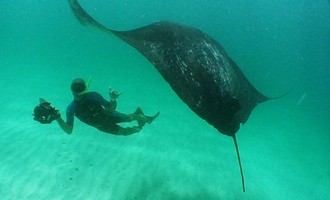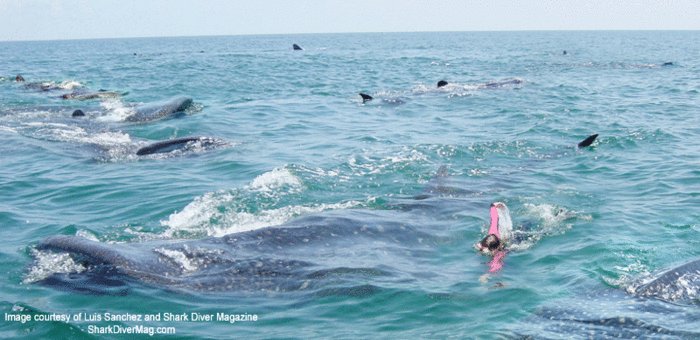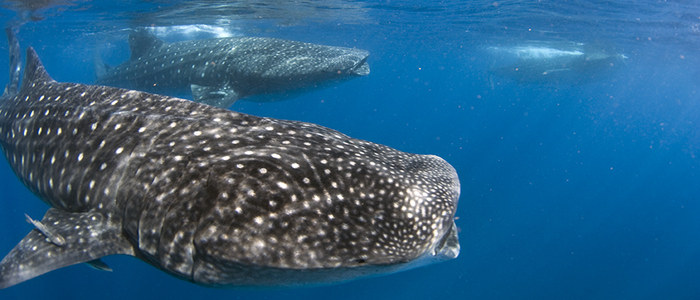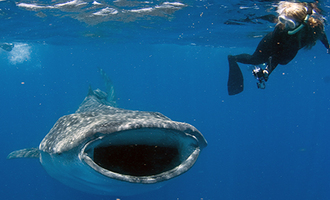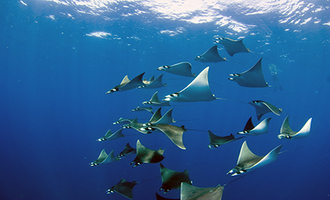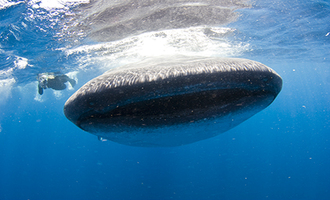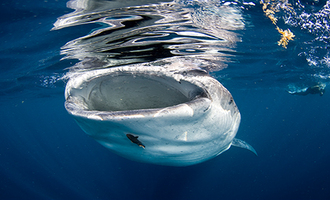Whale Shark - Manta Ray - Snorkel Expedition
Manta & Whale Shark Snorkel Expedition
MANTA RAY - Manta birostris
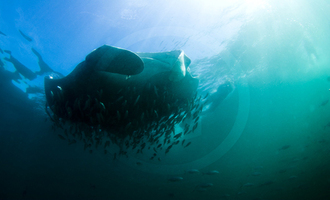
Manta Ray Manta birostris, can grow up to 6.7m (22ft). They are not fish or mammals, but are a member of the shark family, just like whale sharks. I recognise a number of the friendly manta in this area on sight, as I've been studing this particular group of manta since 2005. To swim next to one of these awesome beings from the deep ocean is an incredible experience. We get really close encounters, that exceed even my expectations, and that's a pretty tall order!
Whale shark and manta ray are filter feeders, feeding on zooplankton, small fish and squid. A whale sharks mouth (2-3m/6-9ft wide) can engulf huge volumes of water which is filtered by a sieve-like structure inside the five pairs of gill slits on the sides of the head. Large numbers of manta ray and whale sharks gather at various places, at specific times each year, to feed on rich plankton concentrations, attended by their pilot fish and remora. In 2005-2008 we were seeing whale shark and manta spread out as mostly solo animals, occasionally in pairs in 4 areas West Of Cabo Catoche. 2009-2010 we were seeing 50-80 whale sharks all feeding together, an increddible site. These were in areas both East and West of cabo Catoshe. In 2011 we noticed many of the animals we recognised were missing. Many of the large mature adult whale sharks, and many of the large black manta we knew were gone completely from all areas. This was probably due to the horrific impact of the deepwater horizon oil spill that poisened many of them on their annual mirgration through gulf waters. Recovery of the larger animals is very slow, as they grow extreemely slowly. It is thought that whale sharks live to around 150 years old. By 2012 we are were seeing groups of 30-40 manta ray together, but not the larger black manta, just the smaller black and white variety, and also some mobula rays started to frequent the area. The Western area of Cabo Catoshe was void of all animals and the waters turned dark green. Still in 2013 there were less whale sharks and smaller animals, just 40 or more whale sharks in one small area East of Cabo Catoche. In 2014 over 100 manta ray in with the whale sharks, but less whale sharks in blue waters off of Isla Contoy. In 2015 we saw around 30 manta had returned to the West of Cabo Catoche, along with 20 or more whale sharks. Fewer whale sharks and manta were East of Cabo Catoche than in previous years. In 2016 the animals came much later, we shifted our visit to fit with the change. In nature everything changes, we never know what we will see from year to year. By 2017 whale sharks and manta were back both East and West of Cabo Catoche, however the animals were still small, many being juveniles or young adults. In 2018 and 2019 the larger mature animals were still lacking in numbers. Nature is ever changing, but human impact is now hurting the whale sharks in multiple ways.
As with any wildlife expedition there is never any guarantee from mother nature, so times and length of encounters are up to the animals. That's why we go out multiple days in the areas with the most whale shark and manta, so we really do get the best encounters possible. We are so grateful to have had such amazing success on every expedition since 2005. Our average days are filled with long encounters. This is the most predictable place in the world to see these animals, and we always charter the boat at the absolute best time of the year for encounters and lots of anaimals. We restrict the number of guests on our boat to just six, this is to protect the sharks and enable us to get awesome encounters. Just two people are permitted to snorkel with each whale shark, this makes for outstanding photo opportunities and hours and hours of enounters.
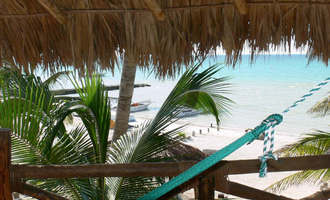
There are lots of bottlenose dolphins in this area. Until just a few years ago, before the protection of the reserve, the dolphins were a target for fishermen to be used as bull shark bait. Whale sharks were also hunted for their fins here. I started my anual expeditions the first year the protection was in place. We will be guided by one of the most experienced of all the local guides. Our Captain has a keen sixth sense for finding the animals and is a genuinly kind man who cares about the animals.
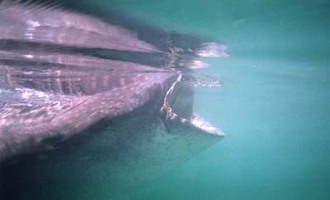
We LOVE sharks... Without sharks in our oceans our planet would loose its balance.
For full expedition itinerary and cost, please e-mail WildOceanAdventures@hotmail.com
WHALE SHARK - Rhincodon typus
It's not a whale, it's a shark. Like baleen whales these huge sharks are plankton eaters, and do not have teeth. Whale sharks are the largest shark on earth. They can attain a length of 18m (60ft) or more and weigh up to 34 tons. In comparison, a big elephant weighs up to 6 tons. Whale sharks have a very distinctive coloration with the dorsal surface covered with white spots and stripes.
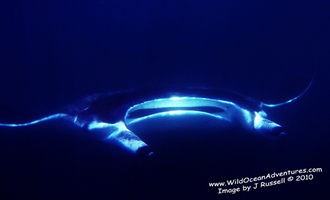
Later in the afternoon when the plankton go deep, so do the sharks and the manta ray. We use the rest of our afternoon to explore other areas like turtle reef, where we see pretty tropical fish, nurse shark and turtles. The mangroves are also a great place to explore at high tide, with tiny glass minnows, and hundreds of tropical birds. We see lots of bottlenose dolphin and if we are really lucky schools of golden cow nose rays or mobula rays or even a sailfish. At night expectant mother turtles come ashore to lay their eggs in the soft warm sand.
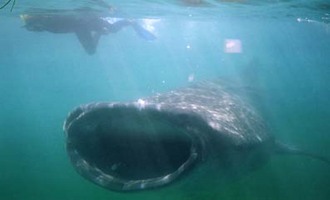
We get the best chance's to see manta and whale shark as we charter the best, safest and fastest boat in the area. We are able to travel fast between Isla Holbox, Cabo Catoche, Isla Contoy and Isla Mujeres depending on which area has the best weather, visability, and number of animals each day. Our informative guide and captain are great at putting us in the right position to get the absolute best encounters possible. We also get a good education of the area. We are out with the professionals, these guys are the best at what they do.
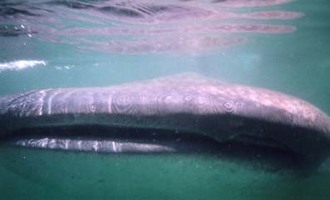
Cancun is our group meeting point as it is an easy airport for most to get to (Cancun International Airport). We then travel 2 hours in our air conditioned taxi van, then half hour on the island ferry, and island taxi, to reach our pretty island hotel. The taxi van journey is air conditioned, and very comfortable. We have a great driver, and we can take photos as we pass through the pretty towns and villages of the northern Yucatan. We also pass through wilderness areas which still have wild jaguar, although they are rare. Comfort stops are made on the journey, and a short visit to the amazing ancient Mayan tree of life and a drive past some unexcatated mayan pyramids is pretty interesting, and it makes the journey very special.
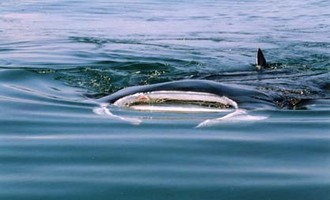
In recent years some captains without permits have been bringing tourists and invading the protected whale shark areas. Photographic study groups in Mexico, are using our images to help local campaigns to prevent rogue boats coming into the protected areas. This is helping prevent injury to whale shark, manta ray, golden cow nose ray, mobula rays, bottlenose dolphin, and six species of sea turtle who nest on the same beach as our hotel. Our daily permit fees (included in the expedition cost) go to the preserve and toward helping protect the animals. I am also working on an educational documentary, using footage from expeditions to help protect them further. By joining us on this expedition you can help protect the animals in a variety of different ways, while experiencing them up close in their own natural habitat.
